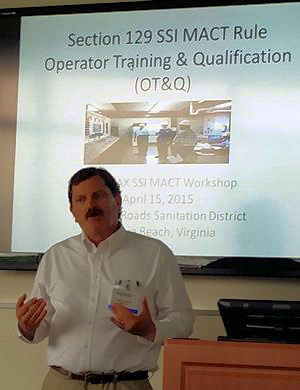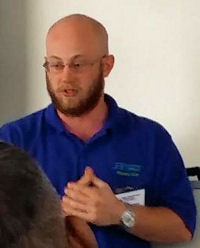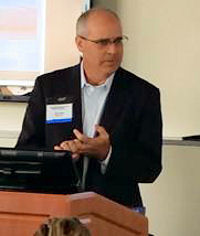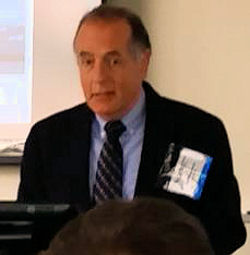
Mark Feltner, environmental scientist at HRSD (Virginia Beach, Va.), provides a review of Virginia operator training and qualification requirements during a WEFMAX meeting. WEF photo/Lisa McFadden.
On April 15, the Hampton Roads Sanitation District (HRSD; Virginia Beach, Va.) hosted a training event during a Water Environment Federation (WEF; Alexandria, Va.) WEFMAX meeting. In order to attend this training event, operators had to meet set criteria under the operator training and qualification (OT&Q) requirements set by the sewage sludge incinerators (SSI) maximum-achievable control technology (MACT) rule.
Water resource recovery facilities that operate SSIs in the Commonwealth of Virginia must meet OT&Q requirements outlined under Title 40 CFR 60.5130 (a-c) of the Virginia statutory code 9VAC5-40-8270. The event, developed to help attendees meet OT&Q requirements under the SSI MACT rule, has been granted state approval by the Virginia Department of Environmental Quality (VA DEQ) Air Division and provided first-of-its-kind training in the nation.

Arba Williamson, water quality specialist at HRSD, joined Feltner in reviewing operator training requirements and instructing participants on the subject areas required of operators. WEF photo/McFadden.
“The common goal of all who attended, which is to be in compliance with the regulations prior to next year’s deadline, provided for a maxed-out room of participants,” said Lisa McFadden, senior program manager in WEF’s Water Science and Engineering Center. “They all were very happy to receive the VA DEQ Air Division certification necessary to meet the training and testing requirement. Due to the number of registrants and room size constraints, it was necessary to cap the number of participants.”
Under the SSI MACT rule, operators are required to meet obligatory certified-and-approved operator training no later than March 21, 2016. This ensures that SSIs operating under Title V permits are in compliance with the law.
Improving wastewater treatment operation relies on operators, explained James Welp from Black & Veatch (Overland Park, Kan.) during the training event. “Outcome is dependent on us better training and [developing] skilled operators, more consistent and holistic plant understanding for steady-state operations, and solids-handling systems of future,” Welp added.
Subject matter experts that helped make the program a success included
- James Welp, vice president, Black & Veatch (Overland Park, Kan.);
- Robert P. Dominak, president, Friar Consulting Inc. (Parma, Ohio);
- Mark Feltner, environmental scientist, HRSD (Virginia Beach, Va.); and
- Arba Williamson, water quality specialist, HRSD.
The WEFMAX training and examination was specifically designed for experienced SSI operators who have been trained on the job and, for a minimum of 1 year, have demonstrated the ability to operate the SSI in compliance with the facility’s existing air permit and other regulations, or have been a supervisor with more than 3 years experience directly overseeing SSI operators with these qualifications. These requirements ensure the operator’s ability to maintain the integrity of the process and its equipment while achieving the purpose of SSI pathogen destruction and solids reduction.

James Welp from Black & Veatch (Overland Park, Kan.) discussed topics ranging from the installation of THC monitors and implementation of nitrogen oxide studies to meeting emission limits. WEF photo/McFadden.
The training provided a rigorous curriculum that began by offering a historical perspective. Welp offered a look back at 1993 and compliance with Part 503 regulations. He discussed topics ranging from the installation of total hydrocarbon (THC) monitors and implementation of nitrogen oxide studies to meeting emission limits. He noted that the pretreatment program has been a great success story.
“[Since 1993] we’ve learned that compliance is possible; … incineration is a viable solids-handling option with a low life-cycle cost, requiring limited space, providing low traffic in the community, killing pathogens, and providing excellent opportunity for resource recovery, such as phosphorus,” Welp said.
Dominak described the background and requirements of the rule, as well as legal- and implementation-issues associated with it. He provided answers to questions, such as a resounding yes in response to, “Do the emission guidelines, new source-performance standards, and operating limits apply during startup, shutdown, and malfunctions?”
Participants also learned that SSIs are required to meet not only the SSI MACT standards but other applicable requirements, such as Title V, Part 503 of the Clean Air Act as well as other state and local operating requirements. Emissions guidelines for existing multiple hearth incinerator (MHIs) and fluid bed incinerators (FBIs) are enforced either through a state implementation plan (SIP) or a federal implementation plan (FIP).
The draft FIP will be published in the Federal Register with comments due 45 days afterwards. WEF’s Residuals and Biosolids Committee will be working with the WEF Government Affairs Committee in reviewing and submitting comments on the draft FIP. The committees also are compiling a list of SSI MACT-related implementation issues that will be submitted to the U.S. Environmental Protection Agency.
Mark Feltner and Arba Williamson of HRSD provided a thorough review of Virginia OT&Q requirements, and instructed participants on the 10 subject areas required of operators, which are
- environmental concerns,
- basic combustion principles,
- operation of type of SSI (MHI or FBI),
- combustion controls and monitoring,
- operation of air pollution control equipment,
- inspection/maintenance of SSI & control devices,
- actions to prevent malfunctions,
- ash characteristics and handling procedures,
- applicable regulations, and
- pollution prevention.

Robert P. Dominak, president, Friar Consulting Inc. (Parma, Ohio) described the background and requirements of the maximum- achievable control technology rule, as well as associated legal- and implementation-issues. WEF photo/McFadden.
Two case study presentations contributed to the operator instruction. Feltner discussed “A Case Study of 10 Multiple Hearth Incinerators (MHIs) and the new MACT 129 Regulations,” and Dominak presented “Achieving Compliance with Fluidized Bed Reactors.” In addition to the case studies, Welp rounded out the discussions with a presentation on SSI MACT implementation issues and concerns.
Section F of the pre-publication draft FIP, released on April 7, proposes requiring that “the owner or operator must qualify operators or their supervisors (at least one per facility) by ensuring that they complete an operator training course and annual review or refresher course. … The FIP also contains operator training and qualification requirements that correspond to the 2011 [emission guidelines].” States also have training requirements that correspond to the rule.
WEFMAX training participants were provided with the opportunity to train and test as a pathway to state approval and compliance. As a result, many Virginia operations are now OT&Q compliant.
— Lisa McFadden, WEF’s Water Science and Engineering Center
WEF Provides SSI MACT Rule ResourcesDuring a Water Environment Federation (WEF; Alexandria, Va.) WEFMAX meeting, the Hampton Roads Sanitation District (HRSD; Virginia Beach, Va.) hosted a training event for operators. The event provided attendees with a way to meet the operator training and qualification (OT&Q) requirements set by sewage sludge incinerators (SSI) maximum- achievable control technology (MACT) rule. For more information about SSI and the rule see
|








May 29, 2015
Featured, Laws & Regs, WEF Resources & Efforts